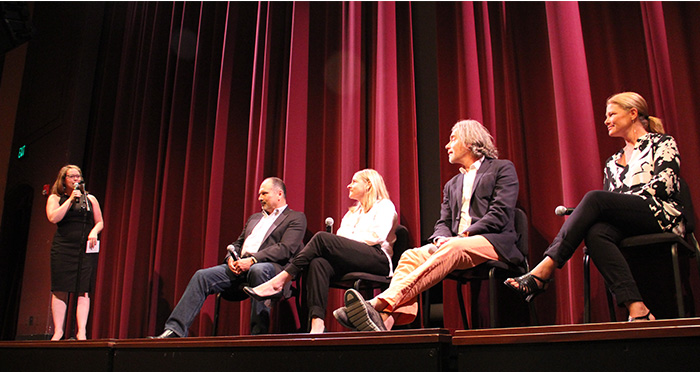(Photo above: Facilitator Erin Foote Morgan moderating post film showing of The Human Scale with panelists, Preston Callicott (Five Talent), René Mitchell (Scalehouse), Victor Chudowsky (Bend City Counselor) and Romy Mortensen (Brooks Resources) | by Krystal Marie Collins)
The Bend Livability Project generated much discussion this weekend, partly as a celebration of the city and partly as a massive town meeting. Running June 2-5 it included over 4,000 participants attending films, parties, public art projects, lectures, panels, workshops, meetings and a west side history planning tour.
Erin Foote Morgan, executive director of Bend 2030 which organized the event, said Central Oregon Radiology Association, OSU-Cascades, the American Institute of Architects, the American Planning Association, City of Bend, Habitat for Humanity and City Club of Central Oregon were among the steering committee partners. Morgan explained the committee was, “proud to offer residents real opportunities for engaging in new housing work groups, multimodal transportation coalitions and tactical policy development groups that have the potential to greatly shape the outcomes of major issues in Bend.”
Following Bend Livability Projects’ opening event, a showing of The Human Scale at the Tower Theatre, Morgan facilitated a panel discussion with Preston Callicott (Five Talent), Victor Chudowsky (Bend City Counselor), Romy Mortensen (Brooks Resources) and René Mitchell (Scalehouse). During the discussion, Morgan asked the panel to comment on the location of Bend’s future downtown.
“Parts of the city are going to change pretty significantly and in a positive way,” Chudowsky said. Variables he mentioned included a projected 35-40 percent population growth in the next fifteen years and the urban boundary plan only allowing for 10 percent expansion. “When people talk about the urban growth boundary there is too much focus on the land being brought in. Most of the change in the city will take place within the current city boundary. We have identified nine areas within the city…the biggest one is back behind Miller Lumber (the Makers District).”
Mitchell added that, “from an arts point of view…what makes me nervous regarding the Makers District is what is taking place there. This place is an organic community of crafters and artisans and quite honestly they congregated there because it was less expensive. They are getting back to sewing and knitting and making furniture.”
She acknowledged that for many of the Makers District businesses, affordability was a concern and the reason they may have chosen this area initially. Mitchell summed up by saying, “my biggest concern is how do we preserve our community values in the face of urbanization?”
Callicott replied saying, “we have to consider the human scale…yes we have to go vertical to accommodate the population growth, but keep it artistic and freaky and cool… we have to consider everything we love just outside the city boundary. Phil’s Trail. The mountain…we all moved here because of what is outside this town, not just what’s in it.”
To which Mortensen said, “Therefore everyone needs to get engaged. If we are enjoying Phil’s Trail, the hiking trails, the river, the wonderful amenities here, we all need to stand up and get involved. It is up to us.”
Allison Murphy, owner and operator of Utilitu Sewing and Design in the Makers District, although not in attendance for the Bend Livability discussion, states, “I suggest we develop the Makers District in a way that supports people; not just one person or company or government entity. Us creative types who don’t own buildings are at the whim of what people with money decide is of value. So far, real estate is of value and so are the businesses that can pay the exorbitant rates of both living and doing business here. The City of Bend and Central Oregon at large would benefit so immensely from having more community friendly and community inducing resources available to them in creative ways in a centrally located area such as the Makers District.”
Though many changes are in store for locals over the next 15 years, conferences like Bend Livability give a platform for discussion. Mortensen reflects on the conference saying, “The crowd on Saturday was impressive. Good speakers, good sessions and hopefully good outcomes. The folks I met were truly interested in being a part of the smart planning that it takes to develop and maintain a wonderful and desirable city. I believe we all want to do what we can to retain its character and the amazing attributes that attracted us here. It is imperative as we move into the future that we all understand growth is occurring and will continue. The way we build, grow and shape our city and amenities, we all have a responsibility in that process.”
Callicott echoed Mortensen’s acknowledgment of continued growth in Bend and mentioned it as one of four “guardrails which frame discussions about Bend’s future…” He agrees with Chudowsky about the urban boundary as a second guardrail and that the result will have to be vertical growth, the third. He points to traffic, the fourth, saying, “with the three preceding factors as given, Bend will not be able to accommodate cars and traffic if we don’t support alternative ways to commute. Bottom-line, any discussion outside of these guardrails is pure fantasy. Any delays in solutions being implemented will be disastrous.”
Callicott also speaks empathetically about how commuting issues in the future will effect low to middle income households and families who increasingly cannot afford to live in Bend.
Find out more and calls to action at http://bend2030.org/





